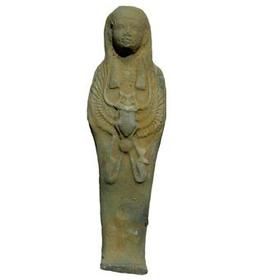Uschebti 15 cm
Uschebtis ca. 15 cm, the servants of the deceased
All Uschebtis are handmade in Egypt from clay and simply fired. Therefore each figure looks slightly different and varies slightly in size.
The small mummy-shaped figures were made from around 1,800 BC onwards and were intended to establish a connection with the god of the dead, Osiris, in the afterlife on the one hand and to perform the prescribed service in the place of the dead on the other. Ideally, a deceased person was to be given 365 usceb - one usceb for each day of the year. The name was derived from usceb (to answer), because they answered the call to work every day.
Detailed description
Uschebti were one of the most popular funerary offerings of ancient Egypt from the Middle Kingdom to Ptolemaic times. Their name is also derived from ancient Egyptian, namely from their late-period name Weschebti, which is generally translated as "answerer".
The Uschebti are statuettes that originally functioned as an image of the mummified deceased, but soon took on a representative function for the deceased if he was called upon to do work in the afterlife. This change in meaning probably went hand in hand with the improving mummification technique, since from the time when mummification could guarantee the integrity of the body, no further precautions in the form of a "substitute body" were necessary.
The oldest surviving Uschebti are simple naked figures made of wax or clay, which apparently had the same sex as the deceased. These small figures were wrapped in mummy bandages and buried in miniature coffins. In a later development, Uschebti were then depicted with unarticulated, i.e. mummy-shaped bodies, and were now mostly formed of stone, wood or faience.
The earliest Uschebti are either uninscribed or bear the name of the deceased. From the 12th Dynasty onwards, they may be inscribed with the so-called sacrificial formula, a standard text requesting offerings for the deceased. It is only from the 13th Dynasty that the text characteristic of Ushabti up to the Ptolemaic period is formed, explaining the tasks and purpose of the Ushabti:
"O you Uschebti, if I am obliged to do any work that is done there in the realm of the dead - namely, if a man is sentenced to do his work there - , then oblige yourself (to do) what is done there, to till the fields and irrigate the banks, to drive over the sands of the east and the west. "I will do it, here I am," you shall say.
At first, the number of the enclosed Uschebti does not seem to follow any rule. Only towards the end of the 18th Dynasty does the ideal of 365 ueshebti, i.e. one per day, develop. Pharaohs were sometimes given even more ueshebti, even around a thousand. In order to be able to carry out their tasks properly, the Uschebti were now equipped with the necessary tools: pickaxes, hoes and ploughs.
Later, from the 19th Dynasty onwards, they were supplemented by overseer figures who supervised that they carried out their work properly and were often equipped with a stick and whip. Thus, each tenth was given an overseer, who was then joined by a chief overseer. These overseers are always depicted in the costume of the living.
From the Middle Kingdom, only Uschebti of private individuals are known. It was not until the 18th Dynasty that the first royal ueshebti appear, which could be elaborately crafted and made of better materials such as alabaster or gilded, but they still had the same task. At the end of the New Kingdom and the beginning of the Late Period, ueshebti were often mass-produced, as can be seen from their poor quality. The most commonly used material in this period was faience. The inscription was roughly painted on and is sometimes difficult to read. Around 30 BC, eschebti disappeared as grave goods.
Text: A. Zdiarsky

